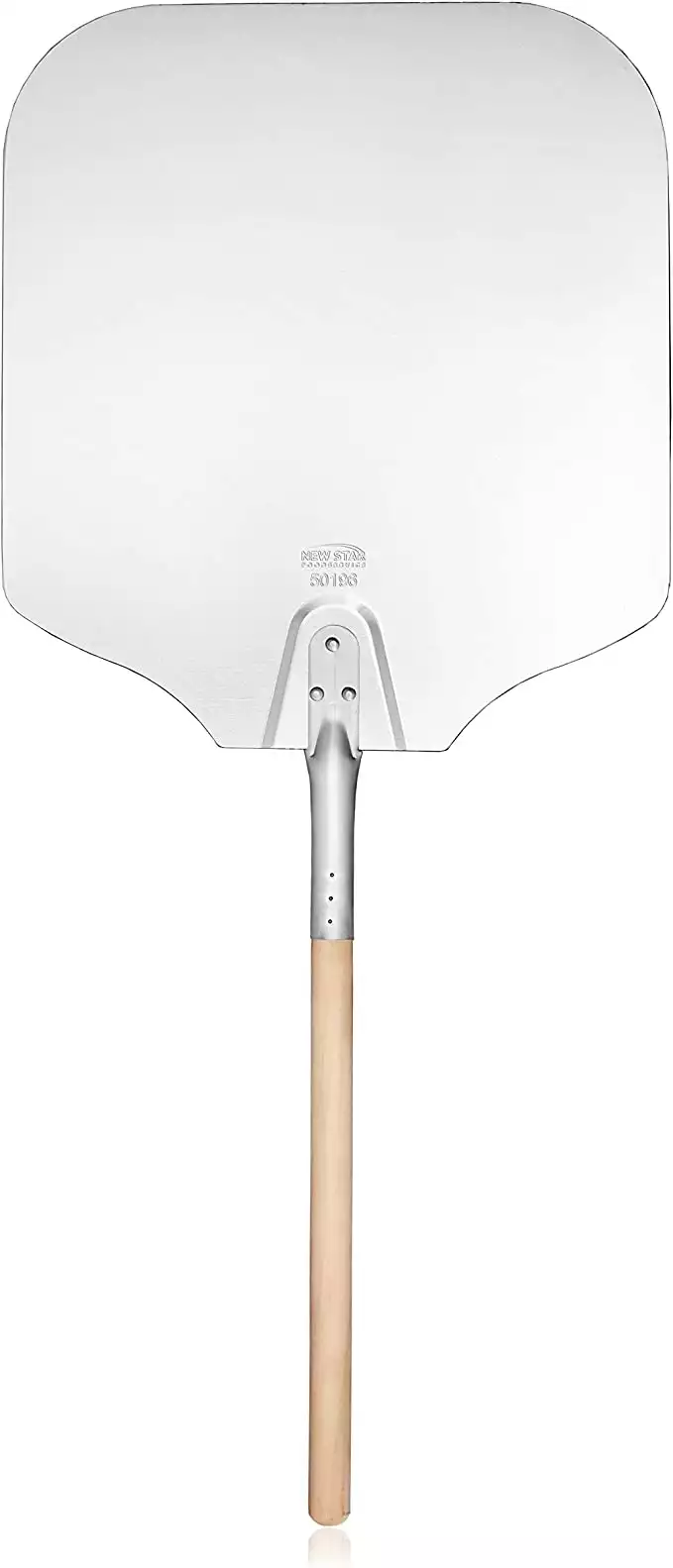wood vs metal pizza peel
Pizza Peel Wood vs Metal? You asked. What’s the difference?
Which one should I get?
So many questions.
But don’t worry; we got you covered.
If you’re a pizza baker (or aspiring to be one), this article will help you understand the purpose of a pizza peel, and what features to look for so you can select the best pizza peel for your needs.
Let’s get started!
Here’s What You Will Find:
Key Takeaways
Wood vs. Metal Pizza Peel
Material Matters: While wood pizza peels are traditionally used and are excellent for launching pizzas into the oven, metal, specifically aluminum, perforated pizza peels offer an unmatched combination of durability, ease of maintenance, and functionality, leading to a superior pizza baking experience.
Perforation Advantage: A perforated pizza peel, typically made of metal, allows excess flour to fall through the holes, preventing it from burning on the pizza stone and affecting the taste of your pizza. This feature gives it an edge over traditional wood peels.
Heat Tolerance: Unlike wood peels that can potentially burn or warp under high temperatures, metal pizza peels, especially the perforated ones, demonstrate high heat resistance, making them a safer and more reliable option for frequent or commercial use.
Ease of Use and Cleaning: Metal-perforated pizza peels are generally thinner and lighter, allowing for more precise handling when transferring pizzas. They’re also easier to clean than wood peels, a significant advantage for regular pizza makers.
Before we dive in, let’s cover a few basics about these tools of the trade.
What Is A Pizza Peel?
A pizza peel is a shovel-like tool used by bakers to slide loaves of bread, pizzas, and other baked goods into and out of an oven. It is usually made of wood, metal, or composite material and has a flat carrying surface (like a shovel’s blade) for holding the baked good and a handle extending from one side of that surface.
Traditionally, the term “peel” is derived from the French word “pelle,” which describes a wide range of long-handled implements. In the world of baking and pizza making, the peel’s primary purpose is to keep the baker’s hands out of the hottest part of the oven or prevent them from getting burned by touching the food directly.
Pizza peels come in various sizes and shapes, and there are two primary types:
A “paddle” or “shovel” peel which has a broad flat surface and is used primarily for inserting pizzas into the oven, and
A “turning” peel is smaller, lighter, and more nimble and is used primarily for rotating and removing pizzas while they’re in the oven.
Perforated pizza peels are a variant of these tools, where the flat surface has a series of holes or perforations. This design allows excess flour to fall off the pizza dough before it’s put into the oven, preventing the flour from burning and impacting the pizza’s flavor.
Picture the ovens at your local pizza joint: do you see the pizza bakers pulling pies in and out of the oven using long tools that appear to be giant spatulas?
Those are pizza peels!

Peels with long handles look a bit like a snow shovel that got run over in the driveway!
For home cooks using a pizza stone or pizza steel, a pizza peel is a valuable accessory that will help you make excellent homemade pies in your oven.

Pro Tip
Make sure that no matter which pizza peel you are using, that is completely dry. Flour the surface and your pizza will never stick.
What Is A Pizza Peel Used For?
A pizza peel is an essential tool in baking, particularly for making pizzas. It has several uses:
Transferring Pizzas: The primary use of a pizza peel is to transfer pizzas in and out of a hot oven.
The flat surface of the peel allows you to slide it under the pizza and lift it out without risking burns.
- Launching Dough: Pizza peels are also used to slide raw, shaped pizza dough onto a pizza stone or baking sheet in the oven. This can be especially useful when making thin-crust pizzas, which can be difficult to handle.
- Turning and Rotating: Pizzas may not cook evenly in the oven if left in one position. A pizza peel, especially a smaller, turning peel, rotates the pizza, ensuring it cooks evenly.
- Serving: A peel can also be used as a serving platter. It’s a convenient way to slice and serve pizza right out of the oven, adding an authentic pizzeria feel to your meal.
- Cooling Baked Goods: Besides pizza, peels are also handy for cooling other baked goods like bread, pastries, or pies, allowing air to circulate around the bottom and prevent fogginess.
Remember, before using a pizza peel, it’s usually dusted with flour or cornmeal to prevent the dough from sticking to its surface.
It has been known as a tool for bakers since at least the 13th century.
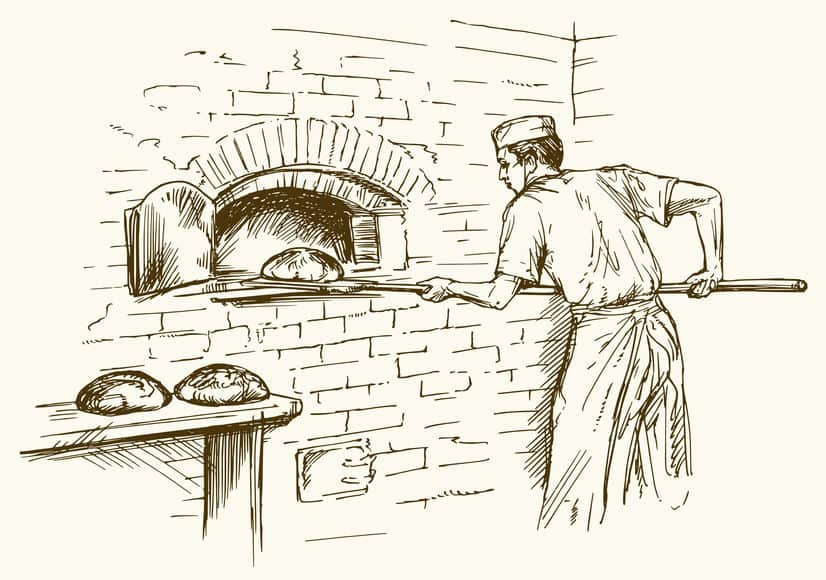
The term peel has been used in the standard description of a baker’s job in the 1806 edition of the Book of Trades.

Peels have become must-have tools in commercial pizza ovens and brick or stone ovens because the baking area is large, and the pizzas usually get baked directly on the bottom surface of the oven like medieval free-form loaves of bread.
What should I look for when choosing a pizza peel?
Choosing the right pizza peel depends on your specific needs, but here are some key aspects to consider:
- Material: Pizza peels are usually made of wood, metal, or composite materials. Wood peels are traditional and provide a good surface for launching dough into the oven, but they require more maintenance and can be bulkier. Metal peels, typically aluminum or stainless steel, are thinner, more durable, and easier to clean. Composite peels offer a middle-ground, balancing ease of use with durability.
- Size: Consider the size of your oven and the pizzas you plan to make. The peel should be large enough to hold your pizza but small enough to maneuver in your oven. Also, consider the size of the handle. It should be long enough to keep your hands safe from the heat but short enough that you can control it easily.
- Handle Design: Look for a peel with a sturdy handle that offers a secure grip. Some peels have foldable handles for easy storage, which could be a deciding factor if you have limited storage space.
- Shape: The shape of the peel’s blade (the flat part that holds the pizza) can impact how easy it is to slide under a pizza. Some people find rounded corners easier to use, while others prefer the precision of square corners.
- Thickness: Metal peels are typically thinner than wooden ones, making it easier to get under the pizza. However, if they are too thin, they can bend under the weight of a heavy pizza.
- Perforation: Some metal peels are perforated with small holes. These allow excess flour to fall away from the pizza as you place it in the oven, preventing the flour from burning on the pizza stone and affecting the taste.
- Ease of Cleaning: Consider how easy the peel is to clean. Metal and composite peels can often be washed in the dishwasher, while wood peels must be hand-washed and dried promptly to prevent warping or cracking.
Remember, the best pizza peel for you will largely depend on your personal preferences, how frequently you make pizza and the type of oven you use.
Wood vs Metal Pizza Peel

There are several styles of peels on the market; depending on your use and budget, you may choose one or two designs!
Pizza Peel Components
Wood vs Metal Pizza Peel
A pizza peel has two main parts: a paddle and a handle.
The paddle area is the surface upon which the pizza sits during transfer to and from the oven, whereas the handle is the part you hold it with. Let’s consider some factors when choosing the best pizza peel.
Pizza Pun
We saw a man cutting a pizza with a smartphone
It’s cutting edge technology but jeez
Paddle Material
Wood vs Metal Pizza Peel

Also known as a blade, the paddle is usually made of wood or metal; composite materials are also available. The material of the paddle generally classifies peels.
Wood
The original baking peels were made of all wood. Today, home cooks have several good choices of the type of wood for their pizza peel.
The best woods are relatively low density, so the utensil does not weigh too much; popular choices include basswood, acacia, and bamboo.
Peels made of wood have the benefit of being sturdy and relatively inexpensive.

Metal
Metal is another popular choice for the paddle end of the peel. Metal paddles are sometimes called ‘blades’ because they are quite thin.
Aluminum and stainless steel are the most common and preferred for durability, strength, and ease of care. The metal peel’s thinness benefits getting the pizza out of the oven.
Composite
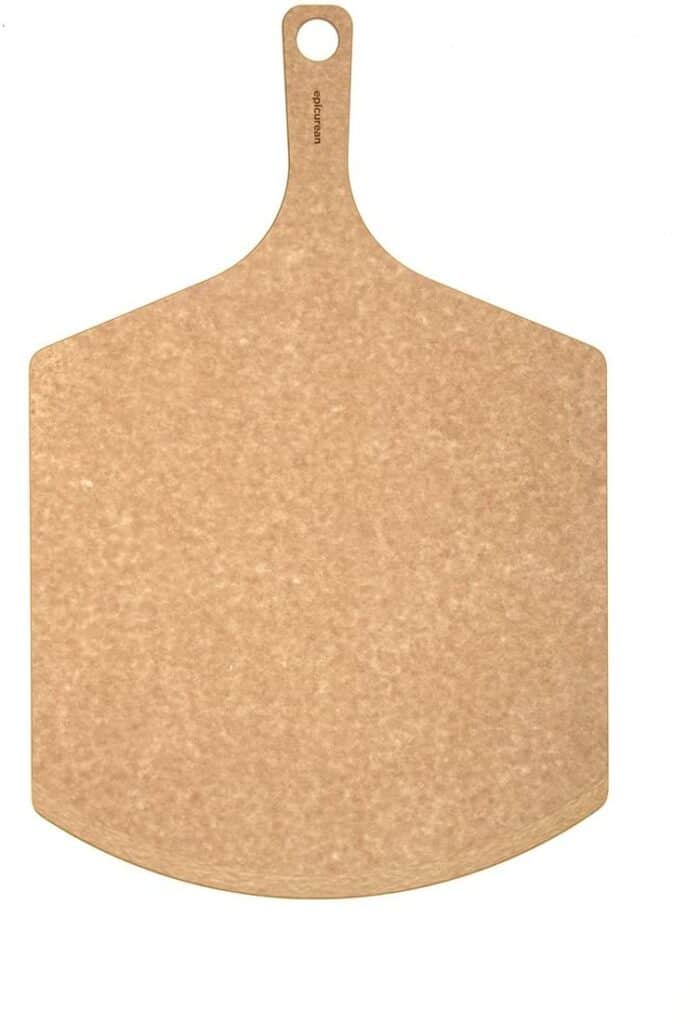
Peels made of pressed paper and similar composite materials are also available but are not well-liked among experienced pizza bakers.
We will, therefore, only consider wood and metal peels from this point.
Paddle size
Yes, Size Matters! The paddle surface’s width or area determines the largest size pizza you can bake, so you’ll need something big enough to make the pies you want but not so big that it doesn’t fit into your oven!

Most peels have a paddle in the 14″ range, allowing you to make a 13-14″ diameter pizza, which is plenty big for most of us. You could go bigger with a large oven (and strong arms).
Peels under 12″ will limit the size of your pies.
Paddle shape
Most paddles are squared off at the end even though pizza tends to be round; this medieval design has endured for centuries for its utility in reaching the farthest corners of the oven and tucking under a baked item.
A gently curved end is also a good choice.
Some commercial operations and wood-fired outdoor pizza oven owners use a small round peel to turn things inside the oven; this specialized utensil is unnecessary for home kitchens.

The shape of the blade edge is critical. Because wood peels have a paddle thickness of about one-half inch where they support the pizza, good wood will be beveled so that the edge is thin, 1/8th inch or less; this is essential for getting your cooked pizza out of the oven.
Metal peels are thin throughout the paddle area, making slipping the blade under the pie easy.
Pizza Peel Handle Material and Design
Material – Wood vs Metal Pizza Peel

Wood peels are generally carved from a single piece of wood, so the handle and the paddle are the same.

The handle may be made of wood or metal or a high-temperature-resistant plastic or silicone for metal peels.
In any case, make sure the peel is rated to 550°F – you don’t want plastic melting onto your food or oven door!
Some peels feature foldable or extendable handles to make storage easier; however, check product reviews to ensure the handle won’t collapse while carrying a topping-laden pizza to the oven.
Pizza Peel Handle’s Length
The handle’s length is essential – a handle that is too short will make your hand feel extremely uncomfortable from the oven’s heat, whereas too long of a handle can be difficult to manipulate and store in a small kitchen.
We recommend a minimum handle length of 7″ up to 12″ for a home kitchen peel– this will allow you to reach the back of your oven without singeing the little hairs on your fingers!
Pizza Peel Overall Weight
All these variations in material, handle length, and paddle size impact the peel’s weight. A well-made peel will deliver the desired features with a weight of fewer than two pounds.
Heavier woods like teak may add a bit of weight, but if you like the look of teak and want to hang the peel on your wall, it may be worth the extra few ounces.
Once the peel is loaded with a big uncooked pizza, it weighs upwards of five pounds, so your ability to carry and manipulate it will be important.
We recommend buying a pizza peel for under three pounds, preferably less than two. Unless, of course, you need bicep conditioning!
Price
Wooden peels are less expensive, whereas metal peels, with their multi-piece construction, tend to cost a bit more.
However, neither is terribly expensive, so dedicated pizza makers may choose to have one of each in their kitchens.
How to Use Pizza Peel
Although the general method for using all pizza peels is the same, there are some subtle differences in technique.
How to Use a Wood Pizza Peel Wood vs Metal
So to get started, you will just need to get a wood peel. Make sure is completely dry.

Total Time Needed: 5 minutes
Total Average Cost: $ 20 USD
Required Tools:
– A Wood Pizza Peel
Ingredients Needed?
– Flour
– Cornmeal
Steps to using a wood pizza peel
Step 1: Flour the Surface of the Pizza Peel
Spread a couple of teaspoons of flour and cornmeal on the pizza peel and spread it around to cover the area where you will place the dough.

Step 2: Stretch the Dough
Place your lightly floured, rolled, or stretched-out dough on the peel and shake it horizontally.
If it does not move freely, add a bit more cornmeal under the sticky spots. Avoiding holes in the dough is important, as the sauce will drip below and cause the pie to stick to the peel.
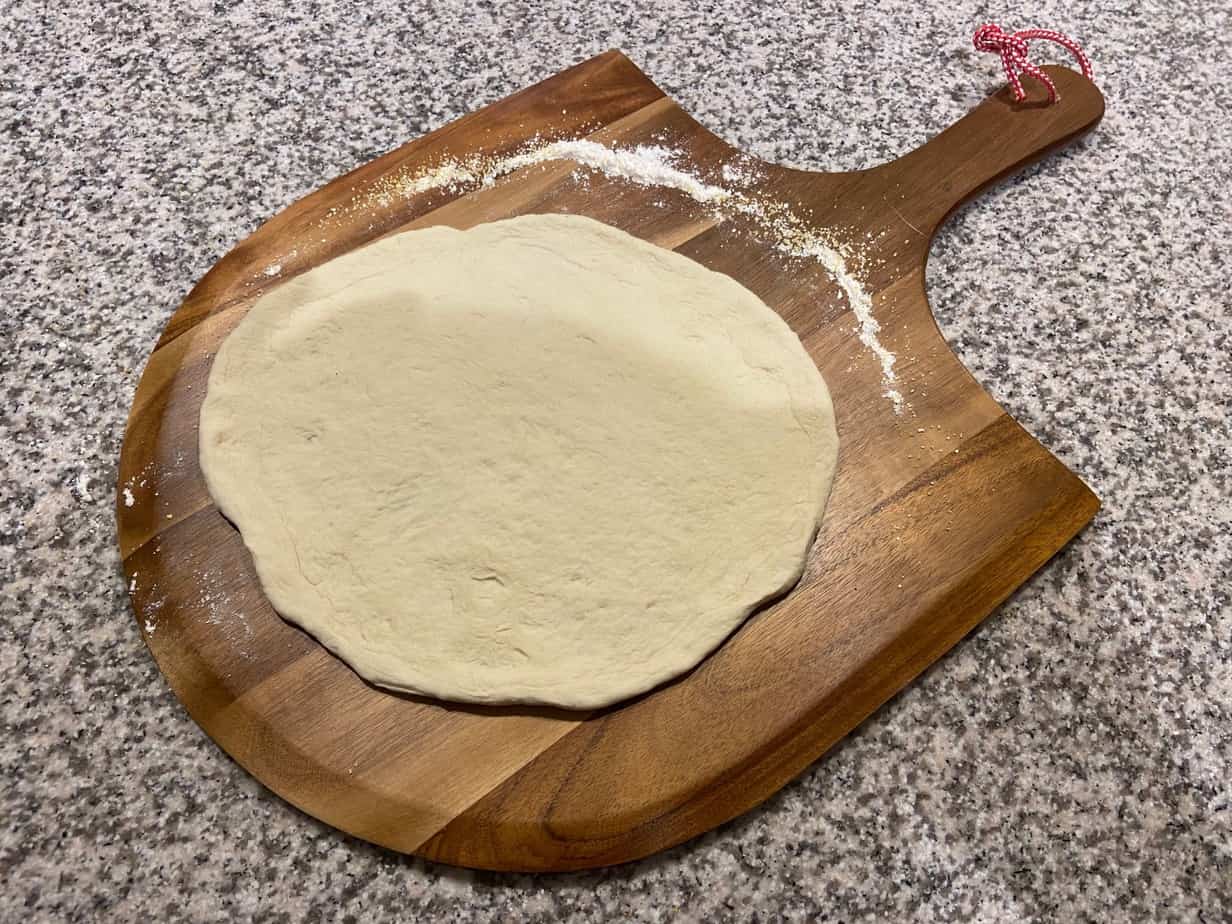
Step 3: Add the Sauce to the Dough
Add your sauce and toppings; work quickly so as not to give the dough too much time on the peel, which increases the risk of sticking.

Step 4: Shake and Transfer the Pizza to the Oven
Pick up the peel and gently shake it horizontally again so the assembled pizza moves back and forth a bit.
Continuing the shaking motion, open the oven and shimmy the dough onto the preheated pizza surface.

Step 5: Remove the Pizza from the Oven
To remove the pizza, place the peel at the edge of the cooked pizza at a downward angle so that the beveled edge contacts the stone’s surface.
Give a strong shove to get the peel underneath the crust.
This step is a bit tricky; sometimes, the pizza will just move to the back of the oven, so you can use the back wall to hold the pizza while you slip the peel underneath.
Alternatively, use a large pair of tongs to grasp the crust and pull it onto the peel.

Step 6: Serve the Pizza
Return the peel to the counter and slide the pizza onto a cutting board or serving platter.

Best practices to use a Pizza peel
Here are some tips to improve the way you use a pizza peel. These are not necessarily what is shown in the photos, but we decided to leave them as they are so you can get a better view of the best practices.
- Make sure your peel is completely dry
- Remove the top rack of the oven so you have more space to maneuver your peel.
- Is best practice to use either a pizza stone or pizza steel as the cooking surface; this will give you a better crust.
- Note the peel has to be at an angle with placing the pizza on the baking surface.
- Pull out the rack when the pizza is cooked; this will dissipate the heat and give you more space to work with. However, you must be careful the pizza won’t slide off the cooking surface. To avoid sliding off, hold the pizza with tongs.
How to Use a Metal Pizza Peel

So to get started, you will just need to get a metal peel. We love using a perforated metal peel for its versatility. Check here for more information on this.
Lastly, make sure is completely dry.
Total Time Needed: 5 minutes
Total Average Cost: $30.00
Required Tools:
– A Metal Pizza Peel
Ingredients Needed?
– Flour
Steps to Use the Metal Peel

Step 1: Flour Working Surface or Countertop
Spread a generous amount of semolina flour or cornmeal on a clean cutting board or countertop.

Step 2: Stretch the Dough
Flour and stretch the dough and place it on this work surface. It is important to avoid holes in the dough, as the sauce will drip through and make the dough stick to the peel.

Step 3: Add the Sauce and the Toppings to the Dough
Add your sauce and toppings; work quickly so as not to give the dough too much time on the countertop, which increases the risk of sticking.

Step 4: Shake and Transfer the Pizza to the Oven
Put a couple of teaspoons of cornmeal/flour on the pizza peel at the blade edge, where you will pick up the pizza.
Slide the blade under the assembled uncooked pizza and gently shake it horizontally so that the dough doesn’t have time to stick to the blade.
Continuing the shaking motion, quickly open the oven and shimmy the dough onto the preheated pizza surface.

Step 5: Remove the Pizza from the Oven
To remove the pizza, place the peel at the edge of the cooked pizza and give a decent shove to get the peel underneath the crust.

Step 6: Serve the Pizza
Regardless of your chosen peel, you will want to practice the techniques before hosting a pizza party!
Caring for your pizza peel Wood vs Metal
How to Take Care of a Wood Pizza Peel
Wooden pizza peels should not be soaked in water or placed in the dishwasher. If you have managed to avoid getting food on the paddle, simply brush off the cornmeal.
If you get sauce or cheese stuck on it (often at the front edge), run it under a light stream of water and use a spatula, bench scraper, or plastic scrub brush to remove the food.
How to Take Care of a Metal Pizza Peel
Metal peels are generally easier to care for; like an aluminum or steel sheet pan, they can be washed in warm soapy water, and some are dishwasher safe.
Check the manufacturer’s use and care information for the specific model you are considering.
Which is the right pizza peel design for me?
How to Choose a Pizza Peel
Let’s discuss the pros and cons of pizza peel wood vs metal pizza peel.
Pizza Peel Wood vs Metal Pros and Cons
Here’s a comparison table outlining the pros and cons of wood versus metal pizza peels:
| Wood Pizza Peel | Metal Pizza Peel | |
|---|---|---|
| Pros | – Natural, traditional look – Absorbs excess moisture from the dough – Dough is less likely to stick – Ideal for launching pizza into the oven | – Durable and long-lasting – Easy to clean (some are dishwasher-safe) – Thinner edge for easy sliding undercooked pizza – Heat-resistant; won’t warp or burn |
| Cons | – Requires more maintenance (hand wash and dry) – Bulkier and may be harder to store – Can warp or crack over time – Thicker edge can make it harder to retrieve pizza | – Can be too hot to touch when removed from the oven – Dough may stick if not adequately floured – May not be as aesthetically pleasing as wood |
Wood peels make it easy to get a pizza into the oven but not so easy to get it out.
The unpolished “fuzzy” surface of a wood peel absorbs some moisture and reduces the amount of contact between the uncooked dough and the paddle.
This feature reduces the risk of the dough sticking to the peel and causing your pizza to deform or spill, which is clearly something you want to avoid!
Once the pizza is cooked, getting it back onto a wooden peel and out of the oven can be a challenge.
Due to the thickness of the wood, it is not easy to slip the paddle under the pizza; this can cause a bit of stress while you are crouched in front of an open 550°F oven, and your pizza is moving farther back into the intense heat!
Although there is some risk of a wooden peel catching fire when using it in a wood-fired oven, this is not a concern for home ranges.
Here are Our Recommended Wood Pizza Peels
 New Star Foodservice Restaurant-Grade Wooden Pizza Peel
New Star Foodservice Restaurant-Grade Wooden Pizza Peel
Sturdy, durable, and lightweight basswood with a fine, even texture ensures our peels are less prone to cracking & free of secreting oils that make their way into your food, separating this product from all other conventional pinewood pizza peels.
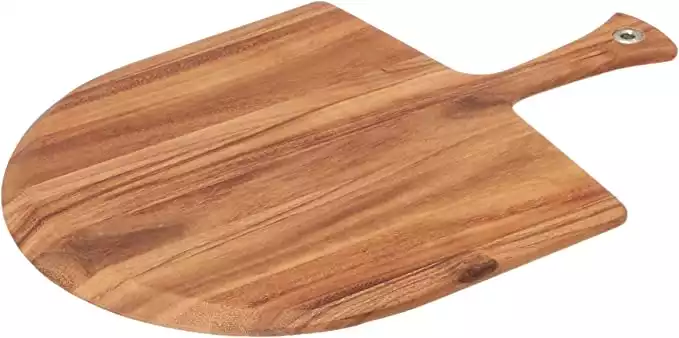 Ironwood Gourmet Napoli Pizza Peel
Ironwood Gourmet Napoli Pizza Peel
Bring ease to the pizza-making process. Bake pizzeria-style in the comfort of your home. Made of gorgeous Acacia, this Pizza Peel is functional and beautiful due to its rich, shimmering colors.
 Heritage Acacia Wood Pizza Peel
Heritage Acacia Wood Pizza Peel
Natural acacia wood is designed to look good enough to hang on the wall in your kitchen. The tapered edge lets you swoop up your pizza out of the oven with ease.
Metal Pizza Peels
Due to the slick, non-absorbent surface of the paddle, metal peels require lots of flour while handling the uncooked pizza to avoid sticking.
When the flour under the pizza dough hits the pizza stone, it can burn and create an unpleasant flavor on the crust – which is a real bummer since you have invested in making better crusts!
Some bakers use semolina flour for this purpose because it burns at a higher temperature.
Other folks use parchment paper and keep the pizza on it the whole time; however, there is a risk of the paper catching on fire, which may produce a strange flavor – or cause great alarm to those around you.
Here Are Our Recommended Metal Pizza Peels
Commercial-Grade, durable anodized aluminum, and natural solid basswood construction make this peel ideal. It has a slimmer design than other wood peel options allowing it to more easily slide under, lift or flip whatever is in the oven.
Bake Like A Pro! Tapered Edge Makes It Easier To Slide Under Dough. Rounded Corners Make It Safe To Handle. Transfer Pizzas Safely And Professionally.
Pizza Peel Metal vs Wood
Here is what you need to look for in a pizza peel.
Of course, it will depend on the kind of oven you have.
Remember that the average kitchen oven reaches temperatures up to 500F, whereas an outdoor wood-fired or gas pizza oven can reach temperatures up to 1000F.
So, let us help you decide which pizza peel is best for You!
Recommended Pizza Peel Specifications
| Pizza Peel | Indoor Kitchen Oven | Outdoor Pizza Oven |
|---|---|---|
| Paddle Material | Wood or Metal | Metal |
| Paddle Size | Up to 14″ | Up to 18″ |
| Paddle Shape | Rounded Square | * Rounded Square for Transfer *Round for Turning |
| Handle Material | Wood | Aluminum |
| Handle Length | From 7″ to 12″ | From 12″ to 48″ |
| Overall Weight | Up to 2 lbs | Up to 2.5 lbs |
Here Are Our Recommended Metal Pizza Peels for Pizzaiolos
(Outdoor Pizza Ovens)
The GA Homefavor Perforated Pizza Peel is a must-have tool for any pizza lover or home chef. Crafted with premium quality stainless steel, this pizza peel is sturdy and durable, ensuring easy handling of pizzas and other baked goods. The perforated design helps prevent sticking, making sliding pizzas on and off the peel effortless.
The long wooden handle provides a comfortable grip and protects your hands from the heat. With its versatile design, this pizza peel is also suitable for handling bread, pastries, and more. Whether you're making homemade pizzas or professional-looking baked goods, the GA Homefavor Perforated Pizza Peel is essential for achieving perfect results every time.
The perforated anodized aluminum allowed you to release off the flour from the dough. The aluminum blade allows you to use on high temperature and comparing with the wood ones, will remain the same quality.
Master Your Pizza Game with Two (2) Pizza Peels
So now you may be thinking, “I still don’t know which is the best pizza peel for me.”
There is no single answer for everyone and every task. For this reason, many pizza chefs have two pizza peels – a wooden one for getting the pizza into the oven and a metal one for getting it out.
This is a great solution if you have the budget to buy both and the room to store them.
However, most of us aren’t going to make pizza every day and may wish to use that space and money for things besides pizza peels!
Don’t Want to Buy Two Different Pizza Peels? Here is the Solution
A new alternative
Perforated Pizza Peel vs Solid

Perforated Pizza Peel
A perforated pizza peel may be your best design if you prefer to buy only one peel. This newer style has perforations, or small holes, throughout the paddle.
The perforated design reduces the surface area in contact with the dough and allows air to reach the underside, thus reducing the amount of flour needed.
Such a hybrid pizza peel combines the thin blade of a metal peel with the lower stickiness of a wood peel; a result is a tool that is good at both getting the pizza into and out of the oven.
Why Use Perforated Pizza Peel
An additional benefit of the perforations is that by shaking the peel’s uncooked pizza, some of the excess flour under the dough can be removed via the holes before placement on the baking stone.
The method for using a perforated pizza peel is mostly the same as that for a metal peel, do a little more (but gentle) shaking of the raw pizza on the peel to allow the extra flour to escape.
You must still work quickly and keep the peel moving to avoid dough dripping through the holes. To minimize this problem, choose a perforated pizza peel with smaller holes.
This is What the PROs at Homemade Pizza Pro Use and Recommend
(Indoor Kitchen Ovens)
The GA Homefavor Perforated Pizza Peel is a must-have tool for any pizza lover or home chef. Crafted with premium quality stainless steel, this pizza peel is sturdy and durable, ensuring easy handling of pizzas and other baked goods. The perforated design helps prevent sticking, making sliding pizzas on and off the peel effortless.
The long wooden handle provides a comfortable grip and protects your hands from the heat. With its versatile design, this pizza peel is also suitable for handling bread, pastries, and more. Whether you're making homemade pizzas or professional-looking baked goods, the GA Homefavor Perforated Pizza Peel is essential for achieving perfect results every time.
This is What the PROs at Homemade Pizza Pro Use and Recommend (Outdoor Kitchen Ovens)
Additional Resources on Pizza Accessories
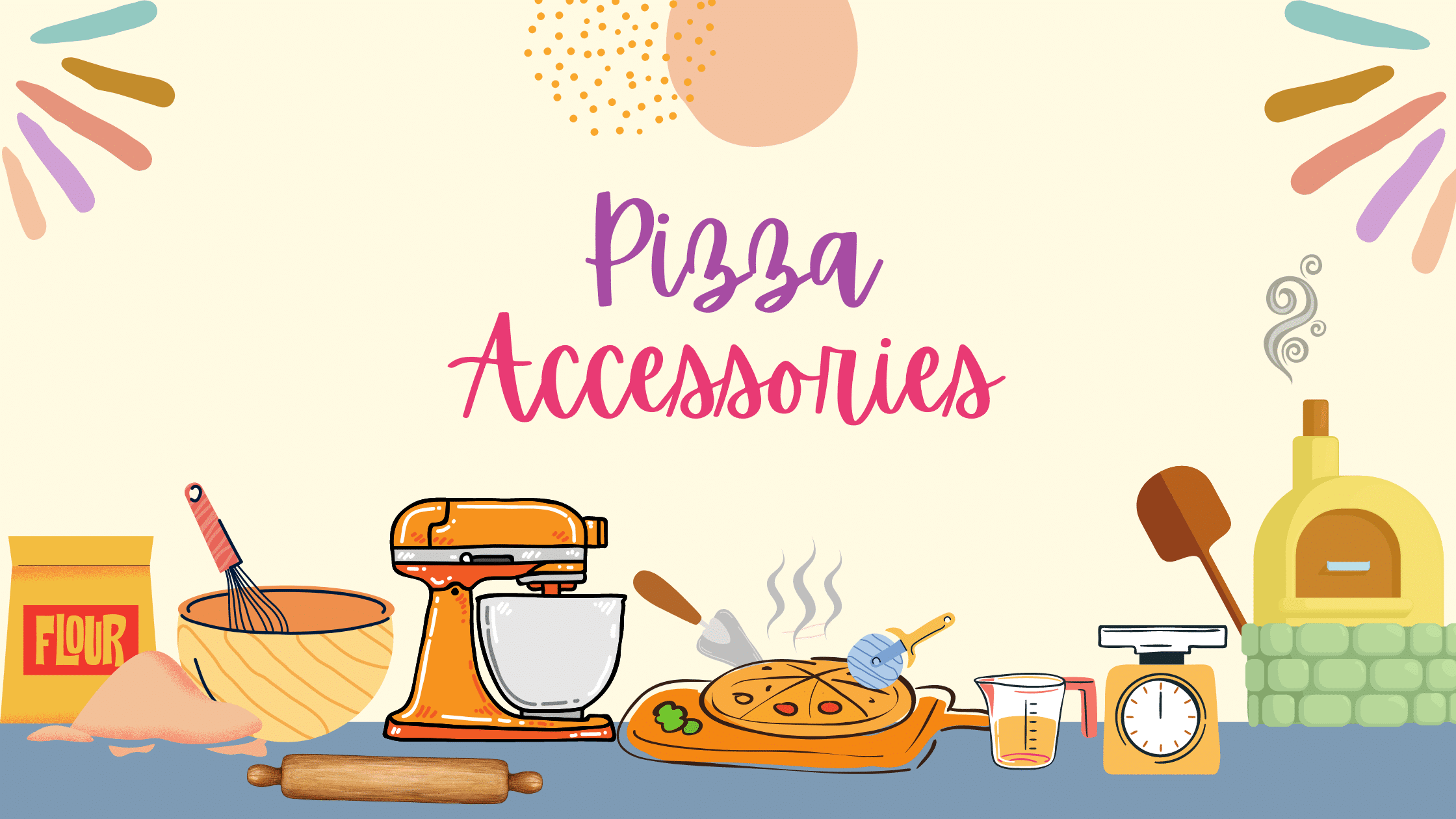
Essential Pizza Accessories You Need to Be a PRO!
the PROs
Pizza Accessories Making pizzas at home is a fun and exciting activity suitable for anybody. Mind you: we are not …

Cool Pizza Cutters: The Best of 2024!
the PROs
Are you looking for cool pizza cutters? Awesome! Here’s what we’ve found, the best for 2024. We have conducted several …

Can You Bake Pizza on Silpat? Yes, You Can! Here’s What You Need to Know
the PROs
Good news! You can use plenty of methods to get the best pizza results from the comfort of your home. …

Ditch the Pizza Stone and Cook Your Pizza on Parchment Paper
the PROs
Can You Cook Pizza on Parchment Paper? Baking Pizza on Parchment Paper As pizza enthusiasts with countless pies under our …

Master the Art of Clean Cut Pizza: [+Tips and Tricks for Perfect Slices]
the PROs
What is Clean Cut Pizza? We know you take your pizza game seriously, and we’re here to help elevate it …

Pizza Spinner: A Game-Changer Tool You Need to Try Today!
the PROs
If you love your pizza and like to bake your pizza, most often than not, you might be already knowing how important it is to have a perfect and evenly baked pizza. You might have often seen your pizza unevenly made, nice and crispy in some areas, whereas soggy and uncooked dough in other areas. To overcome this, we recommend a lot of techniques and tools. Among all the tools and techniques, the one tool that stands out and apart is the Pizza Spinner. But what is it? Let’s find out!

Dough Hook vs Paddle: Know the Difference and Which is Best for an Amazing Pizza Dough
the PROs
In this article, we will break down the process of making pizza dough and answer the common question of which stand mixer attachment to use a paddle or a hook . While more experienced bakers probably have a preference already, beginners will find this useful to guide them through one of the essential steps in the pizza-making process.
The Last Slice
Now that you know all about designs and uses for peels, as well as the benefits of wood pizza peel vs metal pizza peel and perforated peel, we hope you feel confident enough to choose your home kitchen pizza peel.
A perforated or hybrid pizza peel is an excellent choice when you want to buy one versatile tool. If, on the other hand, you don’t mind keeping two around, having both a metal and a wooden peel is a great way to go!
So, what type of peel do you use, or are thinking of buying? Are you ready to try the new innovation of perforated pizza peels? Let us know!
Enjoy!
Not a PRO? Not a Problem!
Take a pizza class to bring your pizza skills to the next level,
so you can be a PRO!
Related Posts

Costco Pizza Delivery: Find How You Can Get It Now!
the PROs
People go to Costco’s food court for many different reasons, but the cheesy slice of pizza they serve is among …

Pizza for Beginners: Don’t Buy Pizza, Make It! Here’s How to Get Started!
the PROs
You have this idea that you want to make pizza at home as opposed to ordering it, but where do you start? Don’t worry! Here you will find answers and directions to all your questions.

Pizza Toppings Under Cheese or Over Cheese? [Why the Order Matters]
the PROs
Is Pizza Cheese on Top or Bottom? Hey pizza lovers, are you wondering if you should layer pizza toppings under …
Newsletter
Subscribe to our Recipe of the Week newsletter and receive our partners’ latest recipes, tips, and discount offers.
Keep in Touch!

